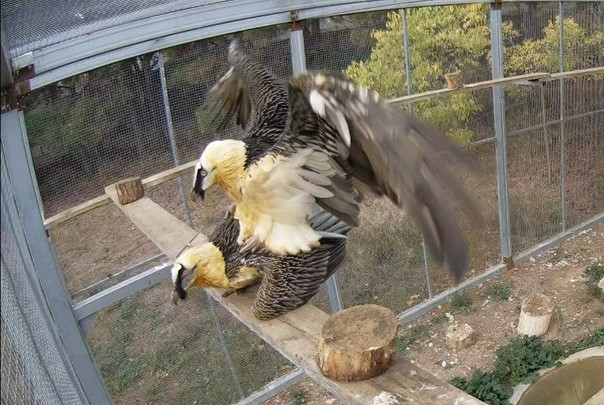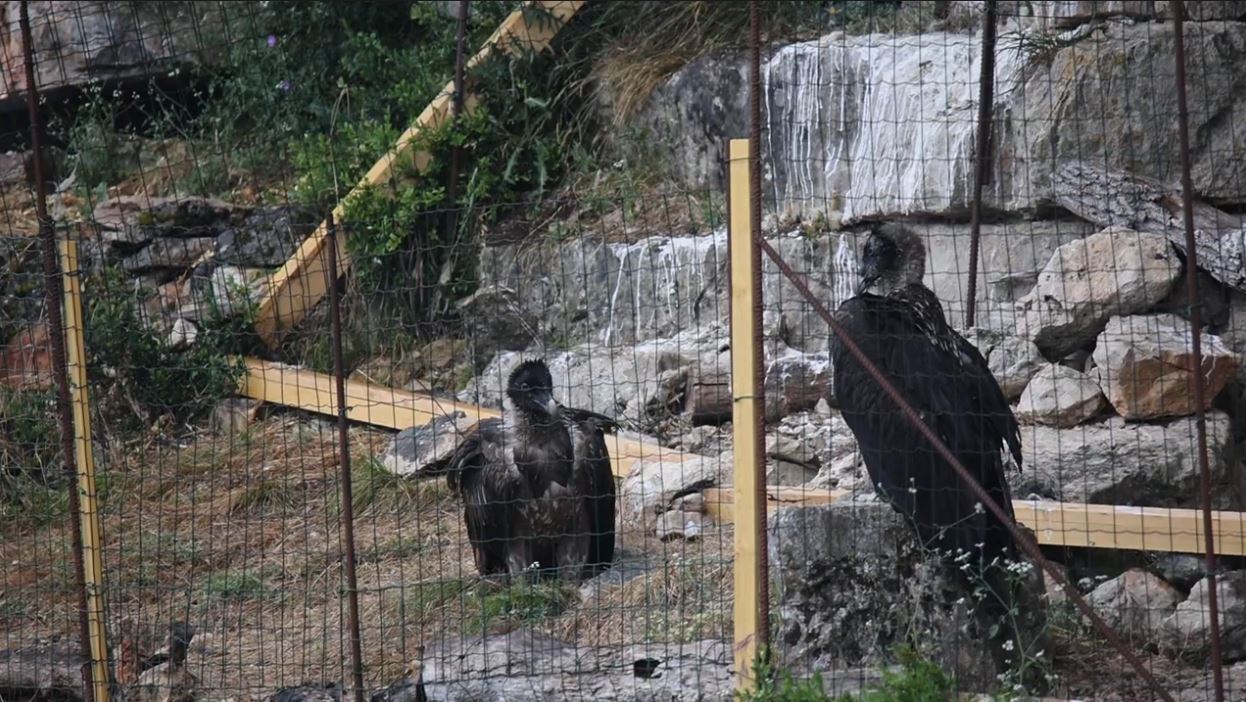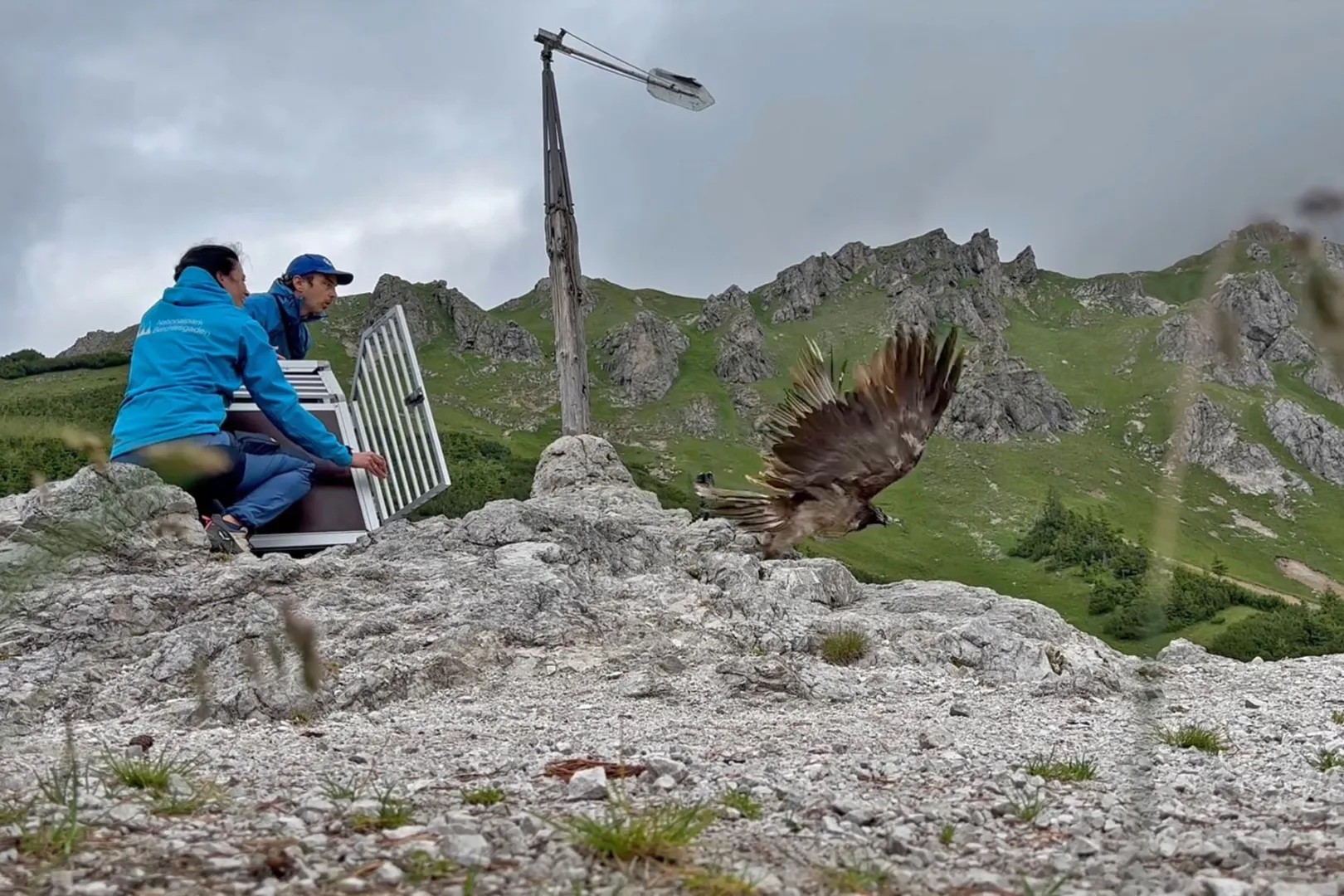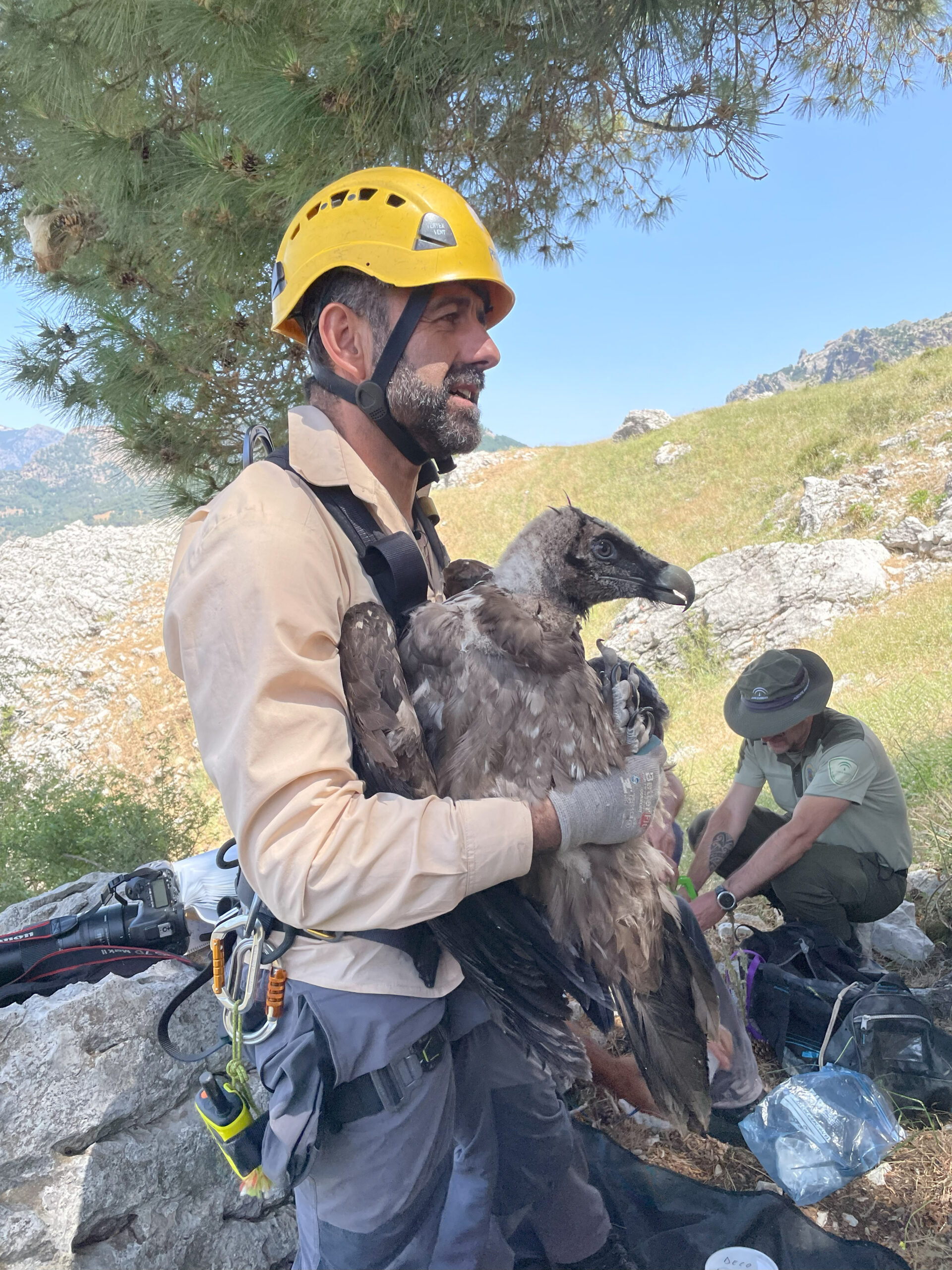The Bearded Vulture breeding season is officially underway within our captive population. Throughout the Bearded Vulture Captive Breeding Network (Bearded Vulture EEP), breeding pairs are busy getting their nests ready, while solitary birds are being introduced to potential partners. Last week, two birds were transferred to our breeding unit in Vallcalent. An adult female named Perea will soon be paired with Bearded Vulture Aïnat and has joined his cage, whilst a young Bearded Vulture, BG1152, now awaits the arrival of his future partner from Goldau, Switzerland. Will Perea and Aïnat bond? Exciting times in our captive breeding centres!

Perea or Aïnat, who rules the aviary?
It was early morning on 26 October when Bearded Vulture Perea left the Guadalentín captive breeding centre in Spain. At 11 a.m., Àlex and Carmen, our VCF staff at the captive breeding unit in Vallcalent, welcomed the bird and released Perea into her new home: Aïnat’s cage.
As Perea entered the enclosure and climbed the nesting platform, Aïnat appeared visibly nervous. After a few minutes, unable to suppress his curiosity, the male cautiously approached Perea. She clearly set the bounds. Perea’s behaviour was not overly aggressive, but it was assertive enough to show Aïnat she was in control. He quickly grasped the message, and remarkably, there have been no conflicts between them thus far. It’s common for females to exhibit dominant behaviours, which can sometimes pose challenges to successful pairing.
From aggressiveness to acceptance: the complexity of bonding Bearded Vultures in captivity
Bearded Vultures have complex bonding dynamics. The first time a male and female are put together in the same cage, one or both can become very aggressive and engage in fights, causing severe injuries or, eventually, fatalities. In other cases, they may not engage in physical aggression but refuse to tolerate each other’s presence, resulting in prolonged conflicts that can span days or even months. However, when a successful match is achieved, these vultures establish robust, lifelong bonds.
“Pairing is one of the most sensitive moments at our job at the breeding centre. We are quite happy this time: Perea and Aïnat are not loving each other yet, but there’s no fight, so we can “relax”.
Carmen Calero, VCF Bearded Vulture captive breeding assistant
With the help of cameras placed within the enclosures, Carmen and Àlex can maintain round-the-clock surveillance of the birds. Currently, it seems that the pair is gradually accepting each other, increasing the likelihood of a successful pairing. Let’s give them some time and hope that love wins!
Aïnat, Pyrenean heritage within the Bearded Vulture EEP
Bearded Vulture Aïnat was taken from a Pyrenean nest in 2008 as part of a programme to rescue second chicks from wild nests to avoid cainism. As one of the founders of the Bearded Vulture EEP, his Pyrenean heritage is significant to the network, and so far, he only had a descendant. As most birds within the EEP come from Asia, genes from different populations are needed to avoid inbreeding between the birds held captive and those released into the wild.
He was adopted and raised in Vallcalent. He was first paired with Greca for several years, but the female always rejected his mating attempts. He was later paired with Sombra, a difficult but successful pairing, and they produced a chick last season, Aïnat’s only descendant. Sombra, however, passed away recently, making Aïnat available to be paired again.
Despite his Pyrenean heritage, he is a huge male (typically, Asian individuals are bigger than Pyreneans) with a playful and skilled nature. With the Guinea pigs and rabbits that live in his cage to graze the grass, he is always mocking with their food plate, even after the team has replaced it with a heavier one. When the breeding season arrives, Aïnat transforms his hyperactive energy into nest-building and showcases exceptional incubation skills, even continuing to incubate dummy eggs long after the season has ended.


Bearded Vulture Perea, a dominant female in control
Bearded Vulture Perea hatched in captivity in 2009 in Schönbrunn Zoo, Vienna, and spent her first two years at the Richard Faust Zentrum. In 2011, she arrived in Guadalentín, Spain, to be paired with Bearded Vulture Montero, with whom she was paired until 2020 but never reproduced. In October 2020, she was paired with Cabús, a bird rescued from the Pyrenees seriously injured, who has been an excellent breeding male for many years. Cabús and Perea had only one chick, Donna Elvira, a female released in Melchsee-Frutt, Switzerland.
Unfortunately, Cabús suffered an accident in October 2021. As he fell from the platform and got injured in his leg, the male is no longer able to copulate. Perea needs to be paired again. She holds an important genetic heritage; her parents, BG201 and BG044, are one of the oldest pairs in the network and have been together over the last 20 years. The female, Perea’s mother, is 43 years old, and the male is around 35, wild-hatched in Tajikistan, probably in 1988. The pair is in Austria and has reared many chicks, their own and adopted ones.
A mud bath… to show dominance?
A few hours after entering the enclosure, Perea took a mud bath. This fascinating “cosmetic behaviour” has triggered the curiosity of many researchers over the last decades. Some researchers consider it a means of showing individual dominance, as both in captivity and in the wild, dominant individuals are often more coloured.
Our experts believe that Perea’s mud bath was a sign that she feels good and relaxed in her new home. Studies have revealed that Bearded Vultures are quite discreet about their bathing habits, and they only engage in this behaviour when they feel entirely secure, as bath time leaves them vulnerable.
Pairing Bearded Vultures in Captivity
New Bearded Vulture pairs are established annually within the Bearded Vulture EEP, which we coordinate on behalf of EAZA’s European Endangered Species Programme. Some birds have lost their partners, others are still waiting for the right match, and others have recently joined the network, either coming from captive breeding centres or rescued in the wild. Pair bonding is a complex task, and Àlex Llopis, Bearded Vulture EEP coordinator and Captive breeding manager at the VCF, is responsible for pairing solitary individuals. Read more about the art & science of pairing Bearded Vultures.




